These articles illustrate all-around information on the “commensal bacteria example”in detail
Some bacteria can produce some signals to inhibit the growth of pathogens or they can able directly act on the host’s immune system to prevent colonization and invasion by pathogens by inducing protective responses termed commensal bacteria.
Now take a look at this all commensal bacteria example in detail.
- Staphylococcus salivarius
- Streptococcus spp.
- Corynebacterium spp.
- Staphylococcus epidermidis
- Bifidobacterium spp
- Faecalibacterium
- Lactobacillus spp.
- Actinobacteria
- Clostridia spp
- Ruminococcus spp
- Bacteroids fragilis
- Streptococcus pyrogens
- Lactobacillus rhamosus
- Neisseria meningitides
Staphylococcus salivarius
These bacteria belong to the species of the Streptococcaceae family.It is the most common commensal bacteria examples. It is facultatively anaerobic, gram-positive, and spherical-shaped bacteria. It acts as a regulator of host inflammatory response and may contribute to the establishment of immune homeostasis.
These bacteria also act as one of the most common and first colonizers of the gut and oral cavity of humans after birth. It is usually considered harmless. A certain strain of this bacteria has various benefits which act as probiotics, one living organism give health benefit to the host.
Streptococcus spp.
These bacteria belong to the species Streptococcaceae family. It is a gram-positive bacteria. It can induce protection against several respiratory pathogens. It acts as an oral commensal such as streptococcus oralis, can induce protection against some host inflammatory responses, and also act as a colonizer of the oral cavity and a part of the normal flora for the human health.

Image from Wikipedia
Corynebacterium spp.
These bacteria belong to the species of the Corynebacteriaceae family. It is the most common commensal bacteria examples.The bacteria are mostly aerobic, bacilli mean having rod-shaped, and some are also club-shaped and gram-positive bacteria. It can provide an advantage for the most beneficial because it can directly attack the infectious pathogen and enhance some immune responses It has a probiotic potential. it aslo have an antimicrobial and antibiofilm potential.
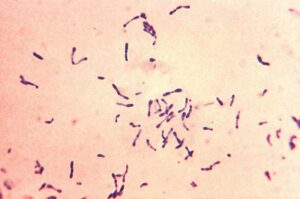
Image from Wikipedia
Staphylococcus epidermidis
These bacteria belong to the species of the Streptococcaceae family and are permanent members of the human microbiota. It is a gram-positive bacteria. The bacteria can able to produce some proteins and provide direct protection against infections and pathogens via working with endogenous host antimicrobial peptides. It can also diminish Inflammation and also give benefit to the skin because they act as a skin microbiome to promote host defense.
Bifidobacterium spp.
These bacteria belong to the species of the Bifidobacteriaceae family.It is the most common commensal bacteria examples It is a gram-positive bacteria. it is also nonmotile and acts as a branched anaerobic. The bacteria act as the most common gastrointestinal microbiota and give benefits as probiotics.
There is a strain of this bacteria including B.bifidum, B.animalis, B.commune, B.breve, and many more that have several functions as a human microbiota. It can act as inhibition of papathogensegulate the intestinal microbial homeostasis and also modulate the systematic and local immune responses.
Faecalibacterium spp.
These bacteria belong to the species of the Oscillospiraceae family. It is a rod-shaped, mesophilic, gram-positive, and anaerobic bacteria. It is one of the most important and abundant commensal bacteria of human gut microbiota. some strain of this bacteria produces some protein which gives some anti-inflammatory effects. The most common species of this bacteria is Facecalibacterium prausnitzii.
Lactobacillus spp.
These bacteria belong to the species of the Lactobacillaceae family. It is the most common commensal bacteria examples. The bacteria have rod-shaped, aerotolerant anaerobes, microaerophilic, non-spore-forming, and gram-positive bacteria.
These bacteria have a very significant role in animal and human microbiota. It can protect against potential invasion by pathogens because these bacteria exhibit a mutualistic relationship with the human body. It can also provide a source of nutrients. The species include L.brevis, L.acidophilus, L.plantarum, L.casei, L.sanfranciscensis, and many more which produce lactic acid as a primary byproduct.
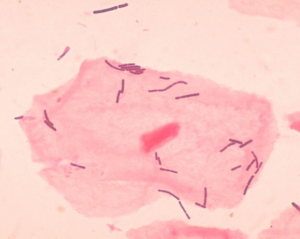
Image from Wikipedia
Actinobacteria
These bacteria are members of Actinomycetota. It acts as an important member of the normal microbiota and most common commensal bacteria examples It is a gram-positive bacteria that is distributed in the terrestrial ecosystems as well as aquatic. It can also act as a decomposer of organic substances. It can also produce a variety of secondary metabolites and can produce different antibiotics for human health. The actinobacteria also act as immunomodifires which enhance the immune responses.
Clostridium spp.
These bacteria belong to the species of the clostridiaceae family.it is a gram-positive, rod-shaped, and spore-forming anaerobes bacteria. They can act as probiotics to directly interact with the gut or are strongly involved in the maintenance of overall gut function, intestine, and the immune system. It can modulate metabolic and immune processes and also interact with other resident microbial populations to provide essential and specific functions.
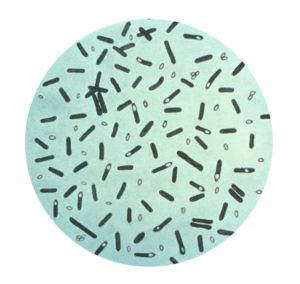
Image from Wikipedia
Ruminococcus spp.
These bacteria belong to the species of the Oscillospiraceae family. These bacteria are gram-positive gut microbes and usually anaerobic and important commensal bacteria examples It can provide a beneficial effect on human health, especially to gut microbiota. It acts a provide strong immune responses toward infection and pathogenicity.it can help and play a major role in digesting complex. high fiber and resistant starch.
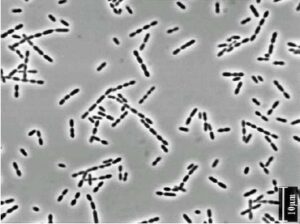
Image from Microbewiki
Bacteroids fragilis
These bacteria belong to the species of the Bacteroidaceae family.It is the most common commensal bacteria examples. It is an anaerobic bacteria. The bacteria are rod-shaped, it is a gram-negative bacteria. The most important role of these bacteria as a part of normal microbiota and to prevent inflammation in the part of the intestine and also act as an antibiotic resistance.
Streptococcus pyrogens
These bacteria belong to the species of the streptococcaceae family. They are aerotolerant, non-motile, and gram-positive bacteria. It is a part of the skin microbiota in humans. but they are pathogenic as well. They are also known as a “microbiome” because they are a part of normal microflora as well.
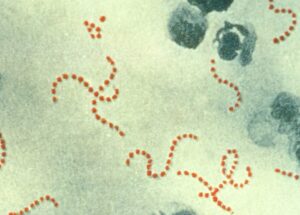
Image from Wikipedia
Lactobacillus rhamosus
These bacteria belong to the species of the Lactobacillaceae family. It is the most common commensal bacteria examples.The bacteria are aerotolerant anaerobes,non-spore-forming, gram-positive bacteria, and microaerophilic. It has a probiotic potential which is generally found in the part of the intestine that acts as a common microflora. They can survive in both conditions either alkaline or acidic. It also has antimicrobial properties and the ability to reduce the harmful and unwanted growth of bacteria.
Neisseria meningitides
These bacteria belong to the species of the Neisseriaceae family. the bacteria have round-shaped, nonmotile, and gram-negative. without any infection, they can act as a colonizer and act like normal flora. It is the most common commensal bacteria examples.The species of this bacteria is harmless to humans.It can act as a phagocytotic inhibitor and antibody via resistance via the part of their capsule.
Also Read:
- Native species examples
- Bryophyte plant example
- Food vacuole in protists
- Do prokaryotes have dna in the cytoplasm
- Moon jellyfish characteristics
- Coenzyme and holoenzyme
- Indigenous species examples
- Do bacteria form endospores
- Protists cell walls and plant cell walls
- Is cytoplasm an organelle

Hello, I am Bhairavi Rathod, I have completed my Master’s in Biotechnology and qualified ICAR NET 2021 in Agricultural Biotechnology. My area of specialization is Integrated Biotechnology. I have the experience to teach and write very complex things in a simple way for learners.